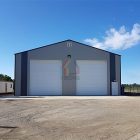Common insulation mistakes in steel structure buildings
With the advancement of science and technology and the increasing awareness of environmental protection, steel buildings have gradually occupied a place in the construction industry due to their advantages such as high strength, environmental protection, and durability. However, despite the maturity of steel building design and construction, insulation issues are often overlooked, leading to some common insulation mistakes. These insulation mistakes will be discussed below and corresponding strategies for solving them will be given.
1. Improper selection of insulation materials
The insulation effect of steel structure buildings depends largely on the insulation materials selected. When selecting thermal insulation materials, some projects focus too much on cost factors and ignore the thermal insulation performance and durability of the materials, resulting in poor thermal insulation effects and even problems such as falling off and damage of the thermal insulation materials.
Solution strategy: When selecting insulation materials, multiple factors such as insulation performance, durability, and cost should be comprehensively considered. At the same time, insulation materials that are compatible with steel materials should be selected to avoid problems caused by material incompatibility.
2. Improper insulation construction technology
The insulation construction of steel buildings requires strict process control. However, some construction teams did not control the process strictly enough during the construction process, resulting in problems such as uneven laying of insulation materials and improper handling of splicing joints, which seriously affected the insulation effect.
Solution strategy: The construction team should strictly abide by the thermal insulation construction process specifications to ensure that the thermal insulation materials are laid evenly and the splices are properly handled. At the same time, quality inspection during the construction process should be strengthened to detect and deal with problems in a timely manner.

3. Neglecting maintenance and repairs
The insulation system of steel structure buildings requires regular maintenance and inspection. However, some users do not pay enough attention to maintenance and repair, resulting in problems such as aging and damage to the insulation system.
Solution strategy: Users should regularly inspect and maintain the insulation system to ensure its normal operation. Any problems that arise should be repaired in a timely manner. At the same time, employee training should be strengthened to improve their understanding and maintenance capabilities of the insulation system.
4. Lack of reasonable ventilation design
In some steel structure building, due to unreasonable ventilation design, indoor air circulation is not smooth, which affects the insulation effect. For example, in some large industrial plants, improper ventilation design will prevent heat from being discharged in time, causing the indoor temperature to rise, increasing energy consumption and cooling costs.
Solution strategy: When designing ventilation, the use function of the building and local climate conditions should be fully considered, and the location and number of vents and ventilation equipment should be reasonably set. At the same time, ventilation equipment should be inspected and maintained regularly to ensure its normal operation. For buildings such as large industrial plants, a combination of natural ventilation and mechanical ventilation can be considered to achieve better insulation effects.
To sum up, common mistakes in the insulation of steel buildings include improper selection of insulation materials, improper insulation construction techniques, neglect of maintenance and overhaul, and lack of reasonable ventilation design. In order to solve these problems, appropriate insulation materials and construction techniques should be selected, construction quality control and maintenance and repair work should be strengthened, and reasonable ventilation design should be carried out. Through the implementation of these measures, the thermal insulation performance and energy efficiency of steel structure buildings can be effectively improved, energy consumption and costs can be reduced, and it is also beneficial to environmental protection and sustainable development.












